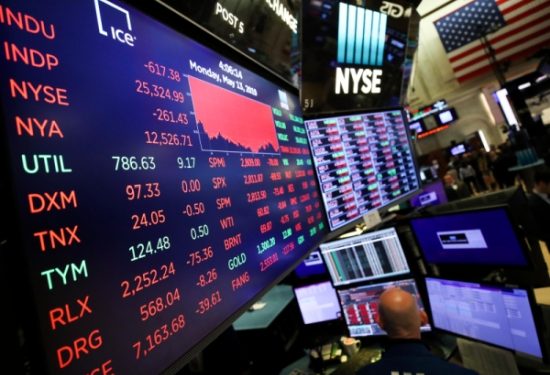New York: Stocks on Wall Street fell sharply Friday after getting hammered by data showing inflation is getting worse, not better, as investors had been hoping.
The S and P 500 was 2.7 per cent lower in morning trading, while moves in the bond market indicated investors’ concerns are building about the economy’s strength. The Dow Jones Industrial Average was down 772 points, or 2.4 per cent, at 31,500 as of 10.27 am Eastern time, and the Nasdaq composite was 3.1 per cent lower.
Wall Street came into Friday hoping a highly anticipated report on the consumer price index would show the worst inflation in generations slowed a touch last month.
Instead, the US government said inflation accelerated to 8.6 per cent in May from 8.3 per cent a month before.
The Federal Reserve has already begun raising interest rates and making other moves in order to slow the economy, in hopes of forcing down inflation.
Wall Street took Friday’s reading to mean the Fed’s foot will remain firmly on the brakes for the economy, dashing hopes that it may ease up later this year.
The growing expectation in markets is for the Fed to raise its key short-term interest rate by half a percentage point at each of its next three meetings, beginning next week.
That third one in September had been up for debate among investors in recent weeks. Only once since 2000 has the Fed raised rates by that much, last month.
“Inflation is hot, hot, hot,” said Brian Jacobsen, senior investment strategist at Allspring Global Investments. “Basically, everything was up. No relief is in sight, but a lot can change between now and September. Nobody knows what the Fed will do in a few months including the Fed.”
A stock’s price rises and falls on two things, essentially: how much cash a company produces and how much an investor is willing to pay for it. The Fed’s moves on interest rates heavily influence that second part.
Since early in the pandemic, record-low interest rates engineered by the Fed and other central banks encouraged investors to pay higher prices for investments. Now “easy mode” is abruptly and forcefully getting switched off.
Not only that, too-aggressive rate hikes by the Fed could ultimately force the economy into a recession. Higher interest rates make borrowing more expensive, which drags on spending and investments by households and companies.
One of the fears among investors is that food and fuel costs may keep surging, regardless of how aggressively the Fed moves.
“The fact is that the Fed has very little ability to control food prices,” Rick Rieder, BlackRock’s chief investment officer of global fixed income said in a statement.
He pointed instead to mismatches in supplies and demand, higher costs for energy and wages and the crisis in Ukraine, which is a major breadbasket for the world.
That raises the threat that the Fed and other central banks will ultimately overly tighten the brakes on the economy, as they push ineffectually against a string “and essentially fall into a damaging policy mistake,” Rieder said.
The economy has already shown signs of slowing, and a preliminary report on Friday said consumer sentiment may be worsening much more than economists expected. Much of the souring in the University of Michigan’s preliminary reading was due to higher gasoline prices.
That adds to several recent profit warnings from retailers indicating that US shoppers are slowing or at least changing their spending because of inflation. Such spending is the heart of the US economy.
The two-year Treasury yield zoomed to 2.94 per cent following the inflation report, after touching its highest level since 2018. It’s up from 2.83 per cent late Thursday.
The 10-year yield was also up, but not as dramatically as the two-year yield, which is more influenced by expectations for Fed movements. The 10-year yield climbed to 3.1 per cent from 3.04 per cent.
The narrowing gap between those two yields is a signal that investors in the bond market are more concerned about economic growth. Usually, the gap is wide, with 10-year yields higher because they require investors lock away their dollars for longer.
If the two-year yield rises above the 10-year yield, some investors see that as a red flag warning of a recession hitting in a year or two.
“A higher-than-expected CPI number seals the deal on investors’ fears,” Mike Loewengart, managing director at E-Trade from Morgan Stanley, wrote in a research note.
“And though consumers may be experiencing high prices in their day-to-day, especially at the pump, it’s disappointing to see that we don’t have a lid on inflation yet, despite the Fed’s efforts.”
The S and P 500 is on track to close out its ninth losing week in the last 10.
Stocks also tumbled in Europe for a second day after the European Central Bank said it would soon raise interest rates for the first time in more than a decade to combat inflation.
Germany’s DAX lost 3 per cent, France’s CAC fell 2.7 per cent, and the FTSE 100 in London dropped 2.3 per cent.
In Asian trading, stocks in Shanghai rose 1.4 per cent following news that inflation remained subdued at 2.1 per cent in May.
With inflation below the government’s 3 per cent target, Chinese leaders have more leeway to offer policy supports for their economy when anti-COVID restrictions may be slowing businesses.
Elsewhere in Asia, Tokyo’s Nikkei 225 index lost 1.5 per cent, while the Kospi in Seoul shed 1.1 per cent.
AP






































